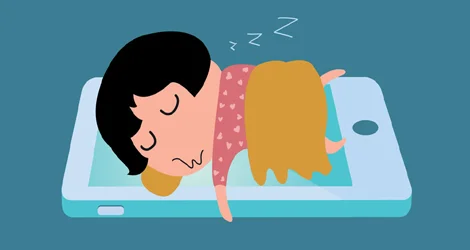There’s nothing that college students immensely value and yet routinely sacrifice as much as sleep. Most people immediately before nodding off for a night’s rest will routinely check their phones to set a morning alarm or to scroll through the latest social media feeds. Our mobile devices are now a necessity during every single moment of our lives, from waking up all the way to going to sleep. The National Sleep Foundation found that close to all adults under 30 years old - 96% total - use a technological device in the bedroom a hour before sleeping.1 So in what ways is using technology before sleep actually harmful and how can these effects be reduced?
Mobile devices, including phones and laptops, have LED screens that emit artificial light with blue wavelength, which is used for its bright illuminating abilities. Within the visible light portion of the electromagnetic spectrum, blue light is closer to UV light with shorter wavelengths.2 In the daylight, these blue wavelengths boost attention and reaction times; however, blue light at night causes disruptive effects on the body’s circadian rhythm. The circadian rhythm controls sleep and wake cycles and responds to changes in light by regulating melatonin, a hormone released by the pineal gland during darkness.3 Melatonin is especially affected by light because before the invention of electricity, changes in sun brightness determined sleeping patterns. Harvard researchers found that blue light exposure, even compared with equal exposure to green light of comparable brightness, suppressed melatonin for twice as long and shifted circadian rhythms by twice as much.4
Besides the screen’s light affecting sleep, electromagnetic radiation from cell phone frequencies and cognitive influences of technology are suggested to affect sleep as well. A preliminary study of 70 participants found that exposure to 884 MHZ GSM, a specific frequency used in mobile phones, increased people's time to reach Stage 3 of deep non-REM sleep compared to those given fake exposure.5 This suggests that electromagnetic radiation exposure, which can result from sleeping with your phone close nearby, has the potential to affect sleep cycle lengths. Additionally, activities including sending emails or texts keeps the brain active and can cause difficulties in entering sleep cycles by stimulating stress or extensive thoughts.
The need to stay connected to the latest news, assignments, and social updates may make it hard to consistently ban electronic devices from the bedroom the hour before sleep. However, there are simple changes that can be made to get the best sleep possible. Apple’s new iOS 9.3 has found a way to mitigate the disruptive effects of blue light to help people get better sleep. With Night Shift as a Display and Brightness option, users can set their phones to automatically reduce the amount of blue light and shift the display to warmer colors with yellow and orange wavelengths around bedtime.This feature, if activated properly an hour or two before sleeping, is an easy compromise to make sure that mobile phone use doesn’t have a negative impact on the limited amount of sleep-time available.6 Some other easy changes include placing your phone further away from your bed instead of under the pillow or at arm’s length and glancing around your surroundings every few minutes of device use to reduce eye strain. Finally, to mitigate cognitive influences of phone use, try to limit your phone and laptop use to passive activities before bed, such as watching videos, instead of active reading or interaction with emails or texts.1 With these small changes, we can all maximize our precious sleep whenever we’re lucky to have it!
References:
Gradisar, M; Wolfson, A; Harvey, A; Hale, L; Rosenberg, R; Cziesler C. The Sleep and Technology Use of Americans: Findings from the National Sleep Foundation’s 2011 Sleep in America Poll. J Clin Sleep Med 2013, 9(12), 1291-1299.
Moore, E. What is the blue light from our screens really doing to our eyes? https://gigaom.com/2014/09/01/what-is-the-blue-light-from-our-screens-really-doing-to-our-eyes/ (accessed 11/12/16), part of Gigaom.
National Sleep Foundation. Melatonin and Sleep. https://sleepfoundation.org/sleep-topics/melatonin-and-sleep (accessed 11/15/16), part of National Sleep Foundation.
Harvard Health Letters. Blue light has a dark side. http://www.health.harvard.edu/staying-healthy/blue-light-has-a-dark-side (accessed 11/15/16), part of Harvard Medical School.
Arnetz, B; Akerstedt, T; Hillert, L; Lowden, A; Kuster, N; Wiholm, C. The Effects of 884 MHz GSM Wireless Communication Signals on Self-reported Symptoms and Sleep — An Experimental Provocation Study. PIERS online 2007, 3(7), 1148-150.
Lopatto, E. Can Apple’s color-shifting screen really help you fall asleep faster? http://www.theverge.com/2016/3/29/11326194/apple-night-shift-blue-light-sleep (accessed 11/12/16), part of Verge News.



